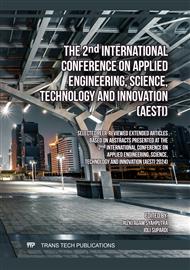[1]
A. Ayoub, B. Gjorgiev, G. Sansavini, 2018, Cooling Towers Performance in a Changing Climate: Techno-Economic Modeling and Design Optimization, Energy, Vol. 160, p.1133–1143.
DOI: 10.1016/j.energy.2018.07.080
Google Scholar
[2]
H. Harman, M. A. Hamarung, 2018, Potensi Pemanas Air Dengan Memanfaatkan Energi Panas Dari Gas Buang Motor Diesel, Jurnal Teknik Mesin, Vol. 3, No. 1, p.229.
DOI: 10.35261/barometer.v3i1.1285
Google Scholar
[3]
C. Y. Yan, 2022, Introduction to Engineering Thermodynamics, Vancouver: BC Campus.
Google Scholar
[4]
S. Subkhan, S. Raharjo, J. Suwiknyo, 2012, Pengaruh Ketebalan Gasket Blok Silinder Terhadap Performance Mesin Suzuki GP 100, TRAKSI, Vol. 12, No. 1.
Google Scholar
[5]
M. M. Patil, S. J. Patil, P. S. Patil, S. J. Mehta, 2018, Design and Analysis of Cooling Tower, International Research Journal of Engineering and Technology, Vol. 5, No. 2, p.2240–2245.
Google Scholar
[6]
D. A. Hersandi, 2018, Pengaruh Jenis Fluida Pendinginan Terhadap Kapasitas Radiator Pada Sistem Pendinginan Mesin Daihatsu Xenia 1300CC, JPTM, Vol. 6, No. 3, p.41–52.
Google Scholar
[7]
R. S. Winda, W. A. Wicaksono, P. Parikhin, 2021, Analisis Kinerja Sistem Pendingin pada Mesin Toyota Avanza Tipe K3-Ve Menggunakan Scanner Lauch Thinkdiag Easydiag 4.0, Jurnal JASATEC, Vol. 1, No. 1, p.23–30.
DOI: 10.37339/jasatec.v1i1.608
Google Scholar
[8]
M. K. A. Ali, X. Huang, 2019, Improving the Heat Transfer Capability and Thermal Stability of Vehicle Engine Oils Using Al2O3/TiO2 Nanomaterials, Powder Technology.
DOI: 10.1016/j.powtec.2019.12.051
Google Scholar
[9]
A. Hamid, et al., 2017, Pengaruh Bentuk dan Konfigurasi Alur Sekat Terhadap Unjuk Kerja Menara Pendingin (Cooling Tower), Jurnal Rotor, Vol. 10, No. 2, p.1–5.
DOI: 10.19184/rotor.v10i2.5291
Google Scholar
[10]
Y. Effendi, A. A. Saputra, 2019, Perencanaan Prototipe Menara Pendingin Mini Untuk Alat Penukar Kalor Tipe Plat Datar, Motor Bakar: Jurnal Teknik Mesin Universitas Muhammadiyah Tangerang, Vol. 3, No. 1, p.1–9.
DOI: 10.31000/mbjtm.v3i1.3074
Google Scholar
[11]
J. Jamaludin, S. Sumarno, 2022, Analisis Perbandingan Laju Perpindahan Panas Filler Material Aluminium dan Plastik Pada Cooling Tower, Motor Bakar: Jurnal Teknik Mesin Universitas Muhammadiyah Tangerang, Vol. 6, No. 1, p.50–53.
DOI: 10.31000/mbjtm.v6i1.6718
Google Scholar
[12]
M. I. Fikri, S. Wuryanti, A. Syafitri, 2022, Perancangan Variasi Bentuk Filler Pada Menara Pendingin Tipe Induced Draft Counterflow di PT. Indolakto – Jakarta, Prosiding The 13th Industrial Research Workshop and National Seminar, p.837–842.
DOI: 10.35313/irwns.v13i01.4176
Google Scholar
[13]
A. Rajai, 2022, Kajian Karakteristik Perpindahan Panas Pada Menara Pendingin Tipe Plat Datar Bertingkat Akibat Pengaruh Letak Lubang, Skripsi Teknik Mesin, Universitas Syiah Kuala, Banda Aceh.
DOI: 10.21776/jrm.v15i2.1699
Google Scholar
[14]
Y. D. Mustika, 2023, Studi Perpindahan Panas Pada Menara Pendingin Tipe Plat Datar Berlubang Dengan Variasi Bentuk Lubang, Skripsi Teknik Mesin, Universitas Syiah Kuala, Banda Aceh.
DOI: 10.21776/jrm.v15i2.1699
Google Scholar
[15]
H. Suansyah, 2023, Pengaruh Jumlah Lubang Pelat Sekat Menara Pendingin (Cooling Tower) Terhadap Keoptimalan Perpindahan Panas, Tesis Teknik Mesin, Universitas Syiah Kuala, Banda Aceh.
DOI: 10.29303/d.v8i1.136
Google Scholar
[16]
F. Aulia, 2023, Kajian Perpindahan Panas Pada Menara Pendingin (Cooling Tower) Tipe Plat Datar Berlubang Segitiga, Skripsi Teknik Mesin, Universitas Syiah Kuala, Banda Aceh.
DOI: 10.21776/jrm.v15i3.1821
Google Scholar
[17]
H. Suansyah, A. Syuhada, S.E. Sofyan, 2023, Effect of Numerous Plate Holes in A Cooling Tower on Heat Transfer Optimization, Jurnal Polimesin, Vol. 21, No. 5, pp.517-522.
DOI: 10.30811/jpl.v21i5.4069
Google Scholar



